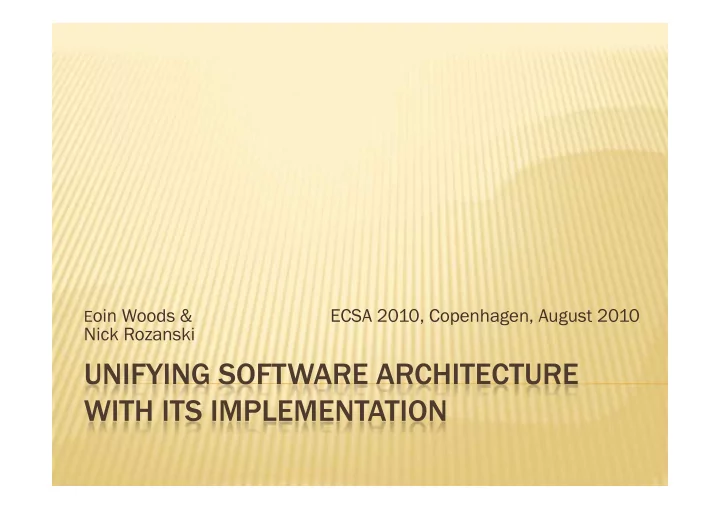

E oin Woods & ECSA 2010, Copenhagen, August 2010 Nick Rozanski
Characterising the Problem motivation for the challenge Existing Research and Practice Connecting Architecture and Implementation existing approaches possible avenues for investigation The Benefits for Research and Practice Summary
Good designers talk about structures that aren’t part of most programming languages layers, adapters, proxies, components, brokers, ... Yet the code is all that exists at runtime or indeed at all in many cases But if we’ve only got code where does all that design information go?
Only language structures are present language structures are fine grained Fine grained nature is very detailed difficult to discern structure from the details Design structures don’t exist need to discern design structure from the code a lot of mapping and assumption required relies on well structured and named code
Interpretation by machine searching checking querying Certainty with respect to runtime “the code doesn’t lie” Integration of different abstraction levels see where a line fits in the overall design People actually write code!
Need to extend our notion of “code” Extend languages to allow design elements Sapir-Whorf – extend language, extend thinking One approach is to create new languages e.g. aspect based languages, Arch Java, .... Alternatively use extension mechanisms comments, annotations, packages, aspects, … supplementary notations adding design information
Naming and conventions classes, packages, files, namespaces, … build systems and binary modules Component models Spring, OSGi, EJB3, SCA, … Metadata .NET attributes / Java annotations / Doxygen comments Commenting structured or informal commenting conventions AOP separate aspects of the design into different code modules
Disclaimer: I’m not a researcher Model driven development generate the code from the design something of a niche, some practical concerns, high commitment doesn’t necessarily address the problem Recovery of architecture from code inevitably struggles because the information is missing, not hidden Architectural description languages usually single dimensional, little direct link to implementation little industrial acceptance (rarely address industrial concerns) Programming language extensions approaches like Arch Java show potential Design decision capture promising work, but solving a different problem
Currently another research / practice disconnect research and practice diverging rather than converging Yet there are signs of the need for solutions industrial module systems (Spring, OSGi, ...) dependency capture and analysis tools annotations, dependency tools (Structure 101, Lattix, ...) design visualisation and comprehension tools Panopticode, Code City, Citylyzer, X-Ray, DrArch, … rules based open source utilities Architecture Rules, Pattern Test, Japan, ... Great opportunity for research/practice collaboration
Accessible, well-defined, embeddable notation Describe what designers design Multi-technology applicability Extensible Focus on functional core of systems Tools to make it easy to write and use Modular and layered Machine processable Freely available ideally open source without patents or difficult licenses
Extending programming languages e.g. Arch Java and similar Augmenting with additional design descriptions e.g. a Groovy DSL to describe system structures annotations to indicate roles and relationships Aspects can they be used beyond logging and security? Visualising more than metrics
public component class PricingEngine { protected owned MarketDataSource marketData = ... ; protected owned StressTester tester = ... ; protected owned PricingPolicyStore policyStore = ... ; connect pattern MarketData.priceService, StressTester.setPrices ; public GraphicsPipeline() { connect(marketData.priceService, tester.setPrices); } public BigDecimal addSecurityToPricingSet(String ticker) { marketData.addSubscription(ticker) ; this.addSecurityOfInterest(ticker) } ... } This example is based on Arch Java syntax http://archjava.fluid.cs.cmu.edu
For example, possible Java annotations @FunctionalElement / @FunctionalInterface @Layer @Tier @PatternElement<T extends Pattern>(T.Role r) @Requires / @DependsOn This is only part of the story though need to tie pieces together across technologies & tiers probably need an overall description (e.g. via DSL) overall description would reference annotated elements
Create ADLs that live in and reference the code part of the system source code, not separate design artefact “compile” the ADL as part of the build Create languages in common technologies e.g. XML / YAML or Groovy / Scala / F# Languages to tie the pieces of the system together overall structure, reference code elements to define the system elements in the ADL description Vocabulary taken from common design elements layer, component, message transport, tier, client, server, database Allow them to be part of the running system e.g. expose ADL elements as MBeans in the JVM
system “fixed_income_support” { tiers { client, server, cache, persistence } client dependsOn server server dependsOn cache, persistence ... } tier “client” { layers { ui, framework, comm, cache} layer “ui” { ... } ... } package com.myco.ui @layer(“ui”)
<architecture> <configuration> ... </configuration> <rules> <rule id="web-layer-separation"> <comment>web and dao mix like oil and water</comment> <packages> <package>com.company.app.web</package> <package>com.company.app.web..*</package> </packages> <violations> <violation>com.company.app.dao</violation> <violation>com.company.app.dao..*</violation> </violations> </rule> <rule id="dao"> ... </rule> </rules> </architecture> This example is taken from the documentation of Architecture Rules http://www.architecturerules.org/
This is Code City primarily showing metrics rather than structure http://www.inf.usi.ch/phd/wettel/codecity.html
Provide software designers with: accurate design information a way of communicating design information in code easier ways of recovering design from code Provide researchers with: a platform to experiment on (like UML or Java) provide a common technology for industrial collaboration Allow the creation of: design recovery, analysis, verification, transformation tools diagnostic and impact analysis tools for production environments Wide use would lead to: domain specific specialisations criticism and the creation of v2!
A lot of design information gets lost in the code Researchers & practitioners see this differently research – a reason for MDA, ADLs & recovery tools practice – rules checkers & analysis tools I personally think there’s a better way stop the information getting lost, augment the code This isn’t easy but could really change things tangible benefits for research and practice
Eoin Woods eoin.woods@artechra.com www.eoinwoods.info Nick Rozanski nick.rozanski@artechra.com www.rozanski.org.uk
Recommend
More recommend